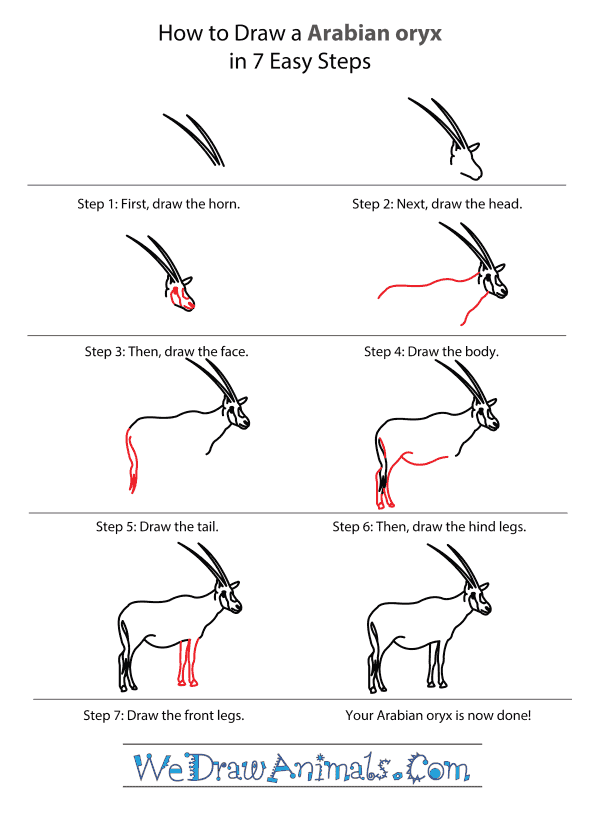In this quick tutorial you'll learn how to draw an Arabian Oryx in 7 easy steps - great for kids and novice artists.
The images above represent how your finished drawing is going to look and the steps involved.
Below are the individual steps - you can click on each one for a High Resolution printable PDF version.
At the bottom you can read some interesting facts about the Arabian Oryx.
Make sure you also check out any of the hundreds of drawing tutorials grouped by category.
How to Draw an Arabian Oryx - Step-by-Step Tutorial
Step 1: Let's start with the horns. Draw two long, slightly curved points.
Step 2: Now you can draw the head - draw a line into a small snout, and with two small ears beside the horns.
Step 3: Detail the face by drawing a circle for the eye, two round shapes for the pattern, and a line for the mouth.
Step 4: Now we can draw the Arabian onyx's body - simply draw two wobbly lines starting from the top and the bottom of the head.
Step 5: Continue the top body line down into a thin tail with fury end.
Step 6: Draw the two hind legs with small hooves at the feet. Draw a curved line for the belly. Leave a gap for the front legs.
Step 7: Draw two more legs at the front with small hooves.
Interesting Facts about the Arabian Oryx
The Arabian oryx (Oryx leucoryx) is an antelope that lives in the deserts of the Arabian Peninsula. Also known as the white oryx, the Abrabian oryx spent many years being confused with another species of oryx before it was declared a separate species.
Did you know?
- In the 1930s, it was popular for Arabian princes and oil owners to hunt the Arabian oryx with rifles and trucks, which assisted in the species extinction.
- The Arabian oryx eats mostly grass, but they will also eat trees, fruit, roots and other vegetation.
- The Arabian oryx is the first animal to ever revert from extinct in the wild back to vulnerable status by being reintroduced back into the wild.
- They form herds that are ten or less on average, made of both males and females.
- Males in herds will take dominance with posture, avoiding actually fighting and hurting each other with their long, sharp horns.
Lesson plan note: The Arabian oryx was driven to extinction in the wild, but still managed to be saved due to the efforts of humans. Discuss what occurred in the history of Arabian oryx to help cause its extinction and how humans could help to avoid it in the future.








